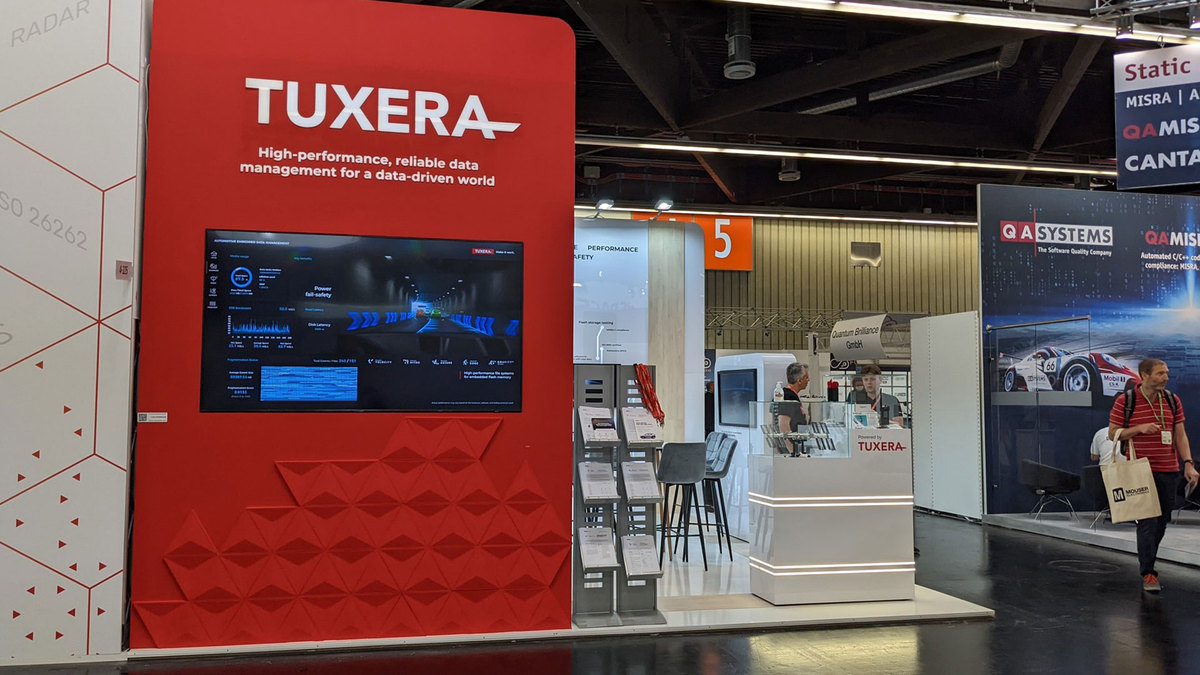Prepare for CRA compliance as Interniche NicheStack TCP/IP will reach end of general support
We at Tuxera are dedicated to developing products that are secure and resilient against the threats of the connected world....
We are here to help
Have a question or need guidance? Whether you’re searching for resources or want to connect with an expert, we’ve got you covered. Use the search bar on the right to find what you need.


As embedded systems become increasingly connected and complex, increased collaboration is needed – and new challenges in safety and security emerge.
2022 marked the 20th anniversary of Embedded World, and the first in-person instance of the event after an entirely digital version last year. It’s no doubt many – exhibitors and attendees alike – were excited to exchange ideas and interact again in person with customers, partners, and thought leaders. Here’s a recap of the industry trends that stood out to us this year.
Embedded systems are growing in use, in tandem with the world’s need for increased data handling and storage. This translates to increased system complexity and data handling, and data storage. The very first conference keynote, by Dr Matthias Klauda, titled “Brains and Nerves of Future Mobility – E/E-Architecture of the Vehicle and Beyond,” helped to emphasize the relevance of this subject. A presentation by Swissbit about flash memory outlined how the massive data creation and capture in embedded devices is driving the need for greater flash memory performance, endurance, and data retention.
Related content: Want to learn more about the data storage challenges in vehicles? Read our whitepaper, “Challenges of tomorrow’s data storage in automotive”
As a result of these needs, new embedded design challenges are emerging, requiring increased collaboration between hardware and software development teams in order to be effectively and efficiently tackled. The term “ecosystems of business” was used to describe this.
Another key topic this year was the growing safety and security risks in connected embedded systems – more specifically in automotive and industrial IoT cases. With autonomous vehicles and smart IIoT devices become increasingly intelligent, the level of data collection, processing, and storage is growing at a very rapid pace. A presentation on embedded vision, by Vision Components, outlined how devices in embedded vision (like smart parking and intelligent traffic systems) are making uses of advanced optic sensors, which could help enable the smart cities of tomorrow. Diving into the subject of security, embedded devices face greater risk from cyberattacks. This fact permeated more than a few talks at the conference this year. More device applications used within a tightly interconnected embedded system means a much greater number of attack vectors are available for hackers to abuse. The large amount of sensitive edge data used by connected devices is only growing, and while encryption is an obvious help, it was emphasized that security must be kept in mind from the very start of the design process – particularly in automotive. Cybellum gave an intriguing presentation on automotive cybersecurity, which covered some of the risks to hacking that connected vehicles face. Of note was the importance of using digital twins of the vehicle in order to conduct sophisticated risk analysis and security testing.
Related content: “How file system encryption ensures data security in connected cars“
As embedded systems become increasingly intelligent, connected, and complex across multiple domains, the need for collaboration between hardware and software is growing. At the same time, that complexity plays a role in leading to deeper safety and security challenges. These were the main trends at the Embedded World Conference in 2022 that piqued our interest. But what could those trends mean for data storage management software? Tuxera has spoken earlier about the need for the embedded industry to keep in mind software and hardware collaboration, particularly in automotive cases, and it was exciting to hear about the topic from more players in the industry. On the flash memory side, the rising memory demands mean that a more comprehensive understanding of the flash memory for a given use case is valuable. Our experts have understood this, and have long worked in close collaboration with OEMs and Tier-1s to determine embedded flash storage needs in a range of use cases. The result is the Tuxera Flash Memory Testing Service, through which our experts work with you to help lower your BOM costs and select reliable, high-performing storage solutions.
RELATED CONTENT: “Tuxera Wins “Best in Show” for Flash Memory Testing Services from Embedded Computing Design“
What’s more, with sensitive data in the vehicle being a potential target of a cyberattack, the system performance and behavior, and the end-user safety, are all at serious risk. As connected vehicle security becomes a potentially larger problem, file systems specialized in data integrity and encryption can play a role in helping to keep vehicle data secure and improve human safety.
Suggested content for: